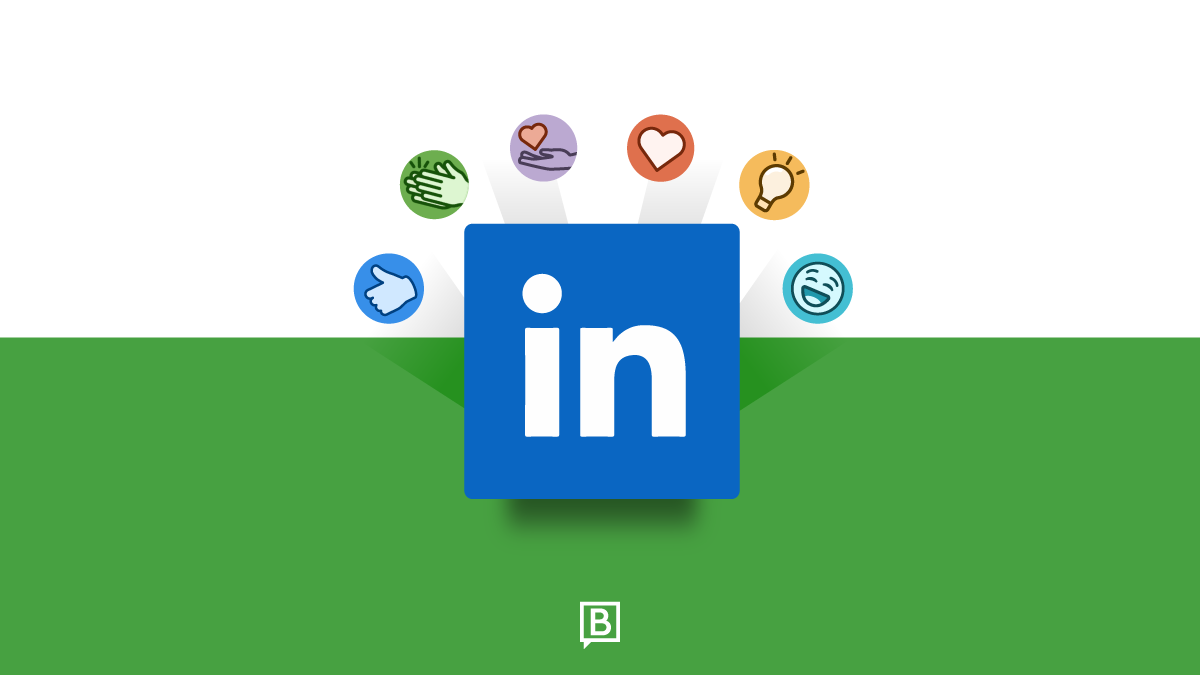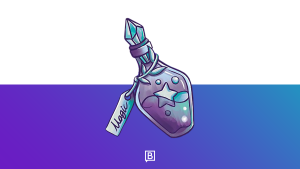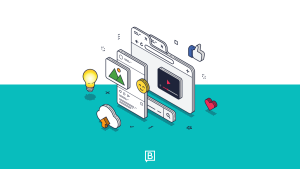Going viral on LinkedIn sounds like the dream, right? Thousands of people seeing your post. Hundreds of comments flooding in. A shiny spike in followers.
I had that moment recently. One post of mine racked up:
- 133,000+ impressions (a 3,600% increase)
- 75,000+ people reached
- 1,631 profile views in just seven days
- 110 new newsletter subscribers (that’s a 3,700% growth spurt!)
- 6% increase in followers
- Even a couple of paid influencer offers
Pretty incredible for something that started as just one opinion post.
But here’s the truth: going viral on LinkedIn isn’t all rainbows and revenue. In fact, it comes with the good, the bad, and the ugly.
This post is part story, part case study, and part lesson for anyone who’s curious about what really happens when you go viral on LinkedIn.
How It Started …
It started with a rant.
I was tired of the LinkedIn pitch slap. You know the drill: You accept a connection request, and 30 seconds later your inbox is flooded with:
“Hey Brooke, thanks for connecting! Let me tell you about my software/product/service…”
So I posted about it. I shared my opinion on why connection requests shouldn’t be a one-way pitch, but a genuine opportunity to start a conversation.
Here’s my post, including the update, which we’ll get to later:
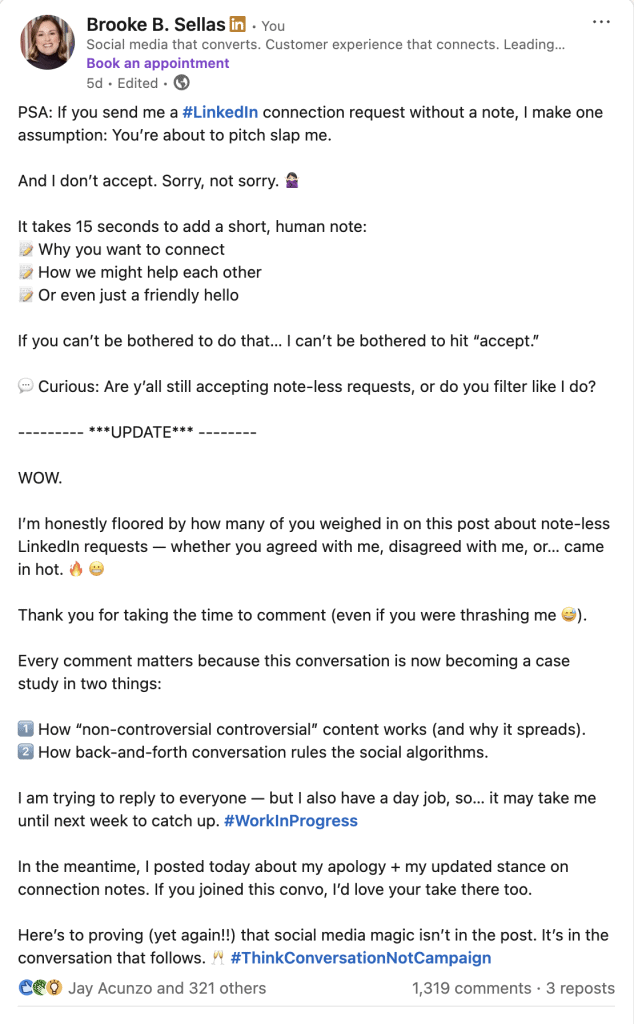
It felt like a throwaway vent post at the time. Nothing fancy. No hashtag research. No clever strategy. Just me being honest about something I was frustrated with.
And then it exploded. 133,000+ impressions. 75,000+ people reached. 1,300+ comments.
Turns out, a whole lot of people are sick of the pitch slap too. But here’s what no one tells you: going viral on LinkedIn isn’t all good news.
So let’s break it down—the ugly, the bad, and the good—and why this “rant” turned into a mini case study on how conversations (not campaigns) on social media win.
The Ugly: Trolls Will Find You
When you reach 75,000+ people, not everyone is going to clap.

[Source: My personal LinkedIn analytics.]
Within hours, my comments section filled with some not-so-nice names:
- “Unhinged”
- “Neurotic”
- “Narcissistic”
- “Stupid”
That was just the highlight reel.
This is the dark side of virality no one warns you about. The bigger the reach, the more likely you’ll attract people who delight in tearing others down.
Lesson: If you want to go viral on LinkedIn, be ready for the trolls. It’s not personal—it’s just math. Big numbers = more chances for criticism. Boundaries and the block button are your best friends.
The Bad: Algorithm Penalties Are Real
Here’s something most people don’t realize: LinkedIn throttles edited posts.
My post was still red-hot when I decided to add a short update about a day later. Almost immediately, impressions nosedived.
Why? Because editing tells LinkedIn’s algorithm: this post changed; slow it down until we can reevaluate.
Here are a few helpful editing tips for LinkedIn posts AND the algorithm:
- The algorithm re-checks your post. Every edit forces LinkedIn to reassess your content. During that re-check, visibility often stalls or drops.
- Engagement can tank. If your updated version doesn’t hit as hard—or interrupts the comment flow—the algorithm may decide to show it to fewer people.
- The “Edited” tag shows up. Too many edits can make you look sloppy or even suspicious. (Not a great look if you’re trying to build trust.)
- Timing matters. Editing within the first hour is the kiss of death for reach. If you must fix something, wait until the post has had a chance to perform.
- Big edits = bigger penalties. Tiny tweaks? Usually fine. Major rewrites (15%+ changes)? The algorithm treats it like a brand new post and resets momentum.
Lesson: If you want to maximize reach, don’t edit a post once it’s live and picking up traction. Instead, drop your clarification or update as a separate post.
Me? I wasn’t mad about the slowdown. 600+ comments were already overwhelming, and frankly, I had other work to do. But if you’re chasing max reach, keep your hands off the edit button!
The Good: The Business Outcomes Were Worth It
Here’s why I don’t regret going viral on LinkedIn for a second:
- 110 new newsletter subscribers
- 100+ new connection requests (still working through them, gulp!)
- A noticeable brand lift for my company page
- Even a couple of paid influencer offers (yes, really!)
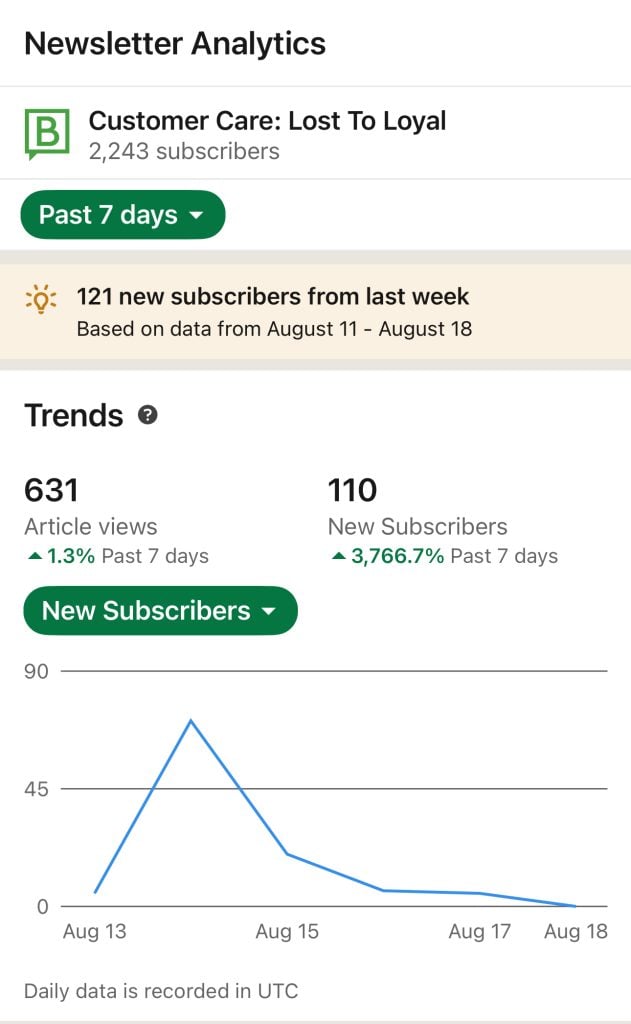
[Source: My personal LinkedIn analytics.]
This wasn’t just vanity metrics! Perhaps most importantly, there was business impact.
And interestingly, even my follow-up “apology” post performed significantly better than my usual posts. Once you have attention, even secondary content rides the wave.
Here’s the follow-up post:

Lesson: Going viral on LinkedIn isn’t just about the big numbers. It’s about how you capture the spillover attention and turn it into subscribers, leads, or trust.
🧅 Why This Worked: The Onion Theory of Connection
Now here’s where I zoom out.
My viral moment wasn’t luck. It was actually predicted by something I researched for my undergraduate thesis: The Social Penetration Theory (aka “The Onion Theory”).

[Source: Conversations That Connect]
The model looks like this:
- Outer layers = clichés + facts (safe, but forgettable)
- Middle layers = opinions + feelings (where connection starts)
- Inner layers = values + self-disclosure (where trust is built)
Most LinkedIn posts live in the outer layer: safe facts, generic advice, recycled tips.
(Let’s be honest, MOST social media content sits here.)
But opinions and feelings are what spark real conversation. They’re riskier, but they invite people in. And when people respond with their own opinions? That’s when conversation takes off.
That’s exactly what happened with my viral post.
I shared an opinion. Others shared theirs. The conversation snowballed. LinkedIn’s algorithm loves conversation, so it pushed the post further.
Lesson: If you want to go viral on LinkedIn—or at least earn meaningful attention—you need to go deeper. Share an opinion. Ask for others. Make people feel something.
🌶️ The Power of “Non-Controversial Controversial” Content
Here’s the funny thing: my viral post wasn’t actually controversial.
Saying “stop pitch-slapping people on LinkedIn” is something almost everyone agrees with. Except for those who kept calling LinkedIn a “sales platform” (but that’s a different conversation for another day).
And yet… it sparked massive conversation.
Why? Because it hit that sweet spot I call “non-controversial controversial” content.
This is content that feels spicy, ranty, or debate-worthy, but doesn’t actually divide your audience in a toxic way. It’s safe heat. And it works because it invites people to pile on with their own stories, frustrations, or opinions.
Think about prompts like:
-
“Spicy take: LinkedIn connection requests should come with a no-pitch period.”
-
“Spicy takes wanted: What’s the one thing that makes you immediately ignore a cold DM?”
-
“Solve this debate: Should brands reply to every comment, or only the ‘meaningful’ ones?”
-
“Opinions needed: Would you hire someone who ghosted you in an interview round?”
-
“Change my mind: Social media engagement matters more than follower count.”
Notice what’s happening? You’re not poking the bear on politics, religion, or truly divisive topics. You’re throwing gas on everyday frustrations, debates, and industry quirks that people are itching to talk about.
And here’s the key: it worked for me because the “pitch slap” directly ties to what I do—helping brands build trust and conversations on social media.
That’s why people didn’t just nod along; they connected the dots between the rant and my expertise. Alignment matters. You want your spicy takes to feel natural to your brand, not like you’re chasing clicks on a random hot-button topic.
This is one of the exact strategies I teach inside my Talk-Worthy Content Course (because you don’t have to go “full viral” to see results). Even a modest wave of comments and conversations can boost your visibility and earn you trust with the right audience.

[Source: Talk-Worthy Content Course]
Lesson: If you want to start conversations (the stuff algorithms love), try serving up a “non-controversial controversial” take. It’s like seasoning your post with just enough spice to get people talking, without burning bridges.
From Conversation to Case Study
This experience reinforced two truths that drive everything I do at B Squared Media:
- Every comment matters. This is why our tagline is “Think Conversation, Not Campaign.” Virality isn’t the goal. Conversations are.
- Conversation > Content. Back-and-forth engagement is the real metric that matters. Algorithms reward it. Customers remember it. And businesses grow because of it.
That’s why I wrote Conversations That Connect and why I created the free Talk-Worthy Content Course. (Yes, this story will soon officially be a case study inside the course!)
Takeaways for Anyone Posting on LinkedIn
If you want to prepare for your own viral moment—or just earn deeper attention on social—here’s what you should know:
-
Expect trolls. Don’t take it personally.
-
Don’t edit a viral post mid-flight.
-
Measure business outcomes (subs, leads, connections), not vanity metrics.
-
Share opinions + feelings to spark conversations.
-
Treat every comment like the gold it is and respond as quickly as possible.
How It’s Going …
Going viral on LinkedIn isn’t the end goal for me. Nor should it be for you. In fact, it’s messy, noisy, and sometimes downright ugly! And who wants that?!
However, when you focus on conversations—not campaigns—you’ll turn viral attention into lasting outcomes.
That’s where the magic happens.
Want More?
🎧 Listen: The Social Media CX Show
🧅 Learn: Talk-Worthy Content Course (FREE)
📖 Read: Conversations That Connect
FAQs About Going Viral on LinkedIn
- What does “going viral on LinkedIn” actually mean? Virality on LinkedIn usually means your post dramatically outperforms your normal reach—sometimes by thousands of percent. For me, that looked like a 3,600% increase in impressions (133,000+ total) and 1,300+ comments in less than a week.
- How many impressions do you need to be considered “viral on LinkedIn”? There’s no magic number—it depends on your baseline. If your average post gets 500 impressions and one suddenly gets 50,000, that’s viral for you. My post reached 75,000+ people, which was massive compared to my usual numbers.
- Does going viral on LinkedIn lead to business results or just vanity metrics? It can go either way. If you focus only on likes and impressions, virality becomes a vanity play. But if you pay attention to conversations and outcomes, it can drive serious results. My viral post led to 110 new newsletter subscribers, a 6% follower increase, and even paid influencer offers. This is likely because I posted a viral topic that aligned with what I actually do for a living (social media).
- How do you prepare for the blowback when going viral? Trolls are inevitable. Big reach = big criticism. Be ready with boundaries, a thick skin, and the block button. Also, know that if you edit your post after it takes off, LinkedIn’s algorithm will likely throttle your reach.
- What type of content is most likely to go viral on LinkedIn? Opinion-based posts that invite conversation. My undergrad thesis on Social Penetration Theory (aka “Onion Theory”) explains why: people connect deeper when you share opinions and feelings. Add in what I call “non-controversial controversial” takes—ranty but safe topics—and you’ve got a recipe for attention.
- What should I do if one of my posts starts to go viral? Jump in and manage the conversation! Respond to comments, engage with people thoughtfully, and use the visibility to drive toward business outcomes (like subscribers, leads, or connections).
Latest posts by Brooke B. Sellas (See All)
- Ready To Find Your Marketing Magic? Take Our Quiz! - November 19, 2025
- Social Media Customer Psychology: Understanding Expectations Elevates Social Care - November 12, 2025
- Seeking A Social Media Mentor? How To Find The Right One To Help You Boost Results That Matter - November 5, 2025
